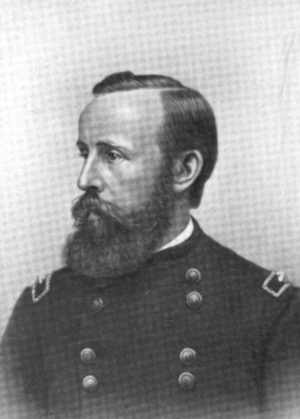Edward Harland (general) facts for kids
Quick facts for kids
Edward Harland
|
|
|---|---|
 |
|
| Born | June 24, 1832 Norwich, Connecticut |
| Died | March 9, 1915 (aged 82) Norwich, Connecticut |
| Place of burial |
Yantic Cemetery, Norwich, Connecticut
|
| Allegiance | United States of America Union |
| Service/ |
United States Army Union Army |
| Years of service | 1861–1865 |
| Rank | |
| Commands held | 8th Connecticut Infantry Regiment |
| Battles/wars | American Civil War |
| Other work | Lawyer, Connecticut legislator, judge, banker |
Edward Harland (born June 24, 1832 – died March 9, 1915) was an important general in the Union Army during the American Civil War. He was known for his role in early battles with the IX Corps and for his service in North Carolina and the Tidewater area of Virginia.
Contents
Early Life and Education
Edward Harland was born in Norwich, Connecticut. He went to Yale University and finished his studies in 1853. Before the Civil War began, he became a lawyer and was working in that field.
Civil War Service
Joining the Army
In 1861, Harland joined the army as a captain in the 3rd Connecticut Volunteer Infantry. He fought in one of the first major battles of the war, the First Battle of Bull Run.
On October 5, 1861, he was promoted to colonel and took command of the 8th Connecticut Infantry. His regiment joined Ambrose E. Burnside's expedition to North Carolina.
Key Battles and Commands
In July 1862, Harland and his regiment returned to Virginia with Burnside. His unit became part of the new IX Corps. Harland was put in charge of the 2nd Brigade, which was part of the 3rd Division, IX Corps. He led his troops in the battles of South Mountain and Antietam.
Battle of Antietam
At the Battle of Antietam, Harland's brigade was involved in the fighting around Burnside Bridge and Antietam Creek. His division commander, General Isaac P. Rodman, tried to go around the enemy's side by crossing Snavely's Ford.
Around 1 p.m., Rodman's troops finally crossed the ford and got behind the Confederate soldiers. As the division moved towards Sharpsburg, General Rodman was badly wounded and had to leave the battlefield. Since Harland was the highest-ranking colonel, he took over command of the 3rd Division.
Harland stayed in command of the division until General George W. Getty took over. Harland then returned to lead the 2nd Brigade. He led this brigade in the Battle of Fredericksburg.
Promotions and Transfers
After the Battle of Fredericksburg, Harland was promoted to brigadier general of volunteers. This promotion was official starting November 29, 1862.
In March 1863, Getty's division, including Harland's brigade, was sent to the VII Corps in the Tidewater area of Virginia. Harland's brigade became the 2nd Brigade, 2nd Division, VII Corps during the siege of Suffolk.
After the Confederates ended the siege, Harland was moved to the XVIII Corps in North Carolina for the rest of 1863. He briefly commanded the Pamlico area.
In July 1864, he was given command of the defenses of New Bern. He stayed in command there until January 1865. At that time, Union forces under General John M. Schofield were moving inland from Wilmington, North Carolina, to meet up with the armies of General William T. Sherman.
Harland’s forces became the 1st Brigade, 1st Division in General Jacob D. Cox's Provisional Corps. They fought in the Battle of Wyse Fork.
Life After the War
Harland left the army on June 22, 1865. He went back to working as a lawyer. He also served as a state legislator in Connecticut, helping to make laws. He was active in the state's militia and became its adjutant general, which is a high-ranking military officer. He also worked as a judge and a banker. He passed away in his hometown of Norwich.

